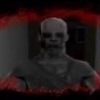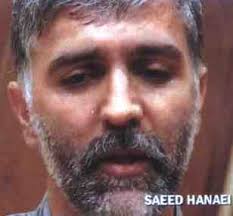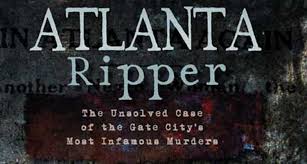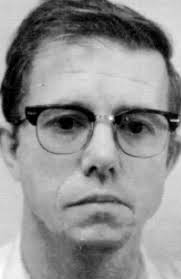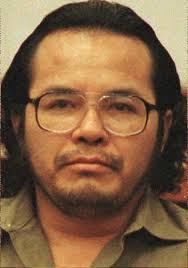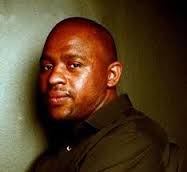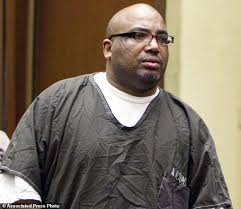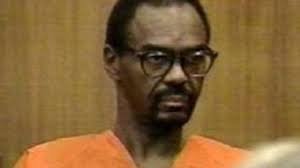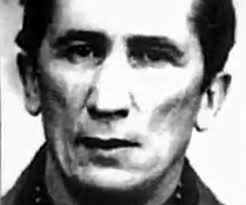When the drought ended and the rains came, Saeed Hanaei believed that it was a sign from God that his killing spree had divine approval. "I realised God looked favourably on me. That he had taken notice of my work," Hanaei said. With 12 prostitutes already dead by his hands, Hanaei carried on his "work" and strangled at least four more women after luring them to his house in the Iranian city of Mashhad. And Along Came a Spider, which had its UK premiere at the Edinburgh festivalyesterday, tells the disturbing tale of a murderous psychopath who found an alarming degree of ideological sympathy among Islamic militants in Iran. The serial killer and his trial attracted a media frenzy in Iran and exposed deep divisions in a society where a conservative-minded minority feels threatened by social change. The director of the documentary, Maziar Bahari, says he believes Hanaei was a murderer by nature who was catapulted to folk-hero status by religious extremists. "Hanaei was living in a very claustrophobic environment and he could somehow justify his killings through ideological slogans that are acceptable in that environment," Bahari says. "He is basically a terrorist. He's not as technologically advanced as some, but the result is the same."
Bahari's documentary provides an extraordinary glimpse into the attitudes of a working-class district in Mashhad and the desperate world of prostitutes entrapped by drug addiction, poverty and patriarchal cruelty. Newspapers dubbed the murders the "spider killings" because of the way victims were drawn into Hanaei's home and then strangled with a scarf. He then dumped the bodies by the roadside or in open sewers, wrapping them in their chadors, the long, flowing black garments that cover a woman from head to toe. Hanaei confessed to the killings, smiled for news photographers and proudly told the court that he was fighting a crusade against moral corruption and vice. He and his lawyer cited an ambiguous provision in Iranian and Islamic law that refers to sinners as a "waste of blood", arguing that Hanaei deserved lenient treatment. The case provoked a debate between reformers who condemned the authorities for failing to catch him earlier and some conservatives who shared the killer's disgust with a rise in prostitution.
"Who is to be judged?" wrote the conservative newspaper Jomhuri Islami. "Those who look to eradicate the sickness or those who stand at the root of the corruption?" Such sentiments are expressed by the killer's merchant friends at the Mashhad bazaar, one of whom says with a laugh: "He did the right thing. He should have continued." The argument over the spider killings represented a kind of microcosm of a wider battle still being waged in Iran over the proper role of Islam in society. Reformists in parliament and government have tried to push for a relaxation of the country's theocratic system, advocating what they call a "democratic interpretation of Islam". Their opponents fear the reformists will only undermine Islam and open the floodgates to secular, western influences. The most disturbing defence of Hanaei comes from his own 14-year-old son, Ali, who says his father was cleansing the Islamic republic of the "corrupt of the Earth". "If they kill him tomorrow, dozens will replace him," Ali says. "Since his arrest, 10 or 20 people have asked me to continue what my Dad was doing. I say, 'Let's wait and see.' "
Those who sympathise with Hanaei remain powerful and vocal, but the majority of Iranians want to see a more tolerant, less ideological society, according to Bahari. "I think they are in the minority, and their numbers are decreasing," he said. Between the scenes of Hanaei recounting his crimes in a matter-of-fact tone, we see haunting photos of the victims before and after they were killed and we meet two children whose mothers were murdered. Interviews with 10-year-old Sahar and eight-year-old Sara provide some of the documentary's most powerful moments. Firoozeh, the 14th victim, went out to buy opium one day at about 5.30pm, says her daughter, Sahar. "We were all waiting for her but she never came home." We see a drawing in crayon from Sara, with a bearded Hanaei in handcuffs, her mother lying dead and a little girl kneeling in despair. Sahar looks away from the camera and says she hasn't spoken to anyone at school about what has happened. She says she wants to be a journalist when she grows up because she hopes to document what happened to her mother.
Hanaei served as a volunteer in the 1980-88 Iran-Iraq war, and described his murders as a "continuation of the war effort". He first became obsessed with "street women" after his wife was mistaken for a prostitute by a taxi driver. We learn from a journalist that Hanaei went looking for men who were soliciting prostitutes and got beaten up. "So he turns to the people who don't have the power to fight back," says the journalist, Roya Karimi. Hanaei had plenty of opportunities to prey on the powerless in Mashhad, a city with all the ingredients for a thriving prostitution trade. While millions of pilgrims visit the city's holy Shia shrine every year, massive amounts of opium pour over the border from neighbouring Afghanistan and are transported through the city. Growing levels of poverty and unemployment, with rural families migrating to cities, have fed the increase in "street women". The spider case forced the invisible world of prostitution into the public arena and government officials can no longer pretend otherwise. But prostitution remains a sensitive issue and Bahari's documentary, which has been shown throughout Europe, has yet to be broadcast in Iran. The criminal code's vague reference to victims deemed to be a "waste of blood" has come under increasing scrutiny from lawyers.
Despite Hanaei's confession in prison that he had "improper relations" with his victims, some ideologues still sympathise with the spider killer. This month a hardline paramilitary group, Ansar-e Hizbollah, warned in its weekly publication that declining morality among women could lead to more such killings: "It is likely that what happened in Mashhad and Kerman could be repeated in Tehran." Although Hanaei was sentenced to death, he was shocked and angry when the moment came for his hanging in April last year. Unlike at his highly publicised trial, there were no cameras around to record how he screamed in protest, baffled that his ideological allies never came to his rescue. "Even until the last second before his execution, Hanaei thought someone in the government would come to save him," Bahari says. Hanaei's case had sparked debate and morbid fascination but not much mourning for the death of the 16 "street women". And Along Came a Spider commemorates these women and grants them a degree of dignity they never received while they were alive.
On July 1, 1911, a 20-year-old woman named Emma Lou Sharpe sat in her house on Hanover Street in Atlanta and waited for her mother to come home. It was a Saturday evening, and Emma Lou was worried. Her mother had left an hour before to fetch some groceries and still had not returned. Usually, this wouldn't be a cause for concern, but these were unusual times. Just two weeks before, a neighbor of the Sharpes named Addie Watts was hit on the head with a brick. Then, as the local papers described in a mysterious understatement, "a coupling pin was brought into play." Watts' attacker then dragged her into a clump of bushes and slit her throat. Watts' murder had been just the latest in a string of attacks that left the local African-American population on edge. All the victims had been of black or mixed race. All had been young, around 20 years old. All had been women. Emma Lou Sharpe fit that description almost exactly, but she was more concerned about her mother, whose name was Lena. Frantic with worry, Emma Lou set out in search of her mother. At the market, she learned that Lena had never showed up. Emma Lou started back for home. In the area that now separates Inman Park from Reynoldstown, she was approached by a stranger, who she described later, according to The Atlanta Constitution, as "tall, black, broad-shouldered and wearing a broad-brimmed black hat."
Hansen was born in Estherville, Iowa, in 1939. His parents were Christian, a Danish immigrant, and Edna Hansen. His father, with whom he had a difficult relationship, was very strict and often made him work long hours at the family-owned bakery. During his childhood, he was often bullied for his stutter and severe acne. In school, he had no close friends. After graduating high school in 1957, he enlisted in the U.S. Army Reserve, where he became a skilled marksman, serving one weekend a month and working at the bakery the rest of the time, sometimes volunteering as an assistant drill sergeant at the police academy in the town of Pocahontas. In 1960, he fell in love with and married a local girl. On December 7 the same year, he burned down the school bus garage of the local high school, but was caught when a friend turned him in. During his three-year sentence in prison, he divorced. After only 20 months, Hansen was paroled even though he had been diagnosed as having an "infantile personality". In 1963, he remarried a woman with whom he had two children. In 1967, after several jail sentences for petty theft, he moved to Anchorage, Alaska with his family. Well-liked by people who knew him, he became an avid hunter, breaking several hunting records (his records were nullified after his conviction). His weapons of choice were rifles or bow and arrow. The year after his last record breaking, he was convicted of raping a prostitute and attempting to rape a housewife, but only served six months in prison. In 1977, he was imprisoned again for stealing a chainsaw and was diagnosed with bipolar disorder. He was prescribed lithium, but wasn't required by law to actually take it. He was released after only a year. In the early 1980s, he reported a burglary on his home, which he had actually staged. With the money he got from the insurance company, he opened up a bakery of his own and established himself as a well-liked family man. In January 1982, he bought himself a Piper Super Cub bush plane, even though he had been denied a license due to his medication.
During later questioning, Hansen claimed that starting in 1973, after finishing his rape sentence, he became a serial rapist, picking up prostitutes from Anchorage's tenderloin district and taking them by his bush plane to the wilderness, where he would rape and torture them. He later claimed that the ones who complied, he would return to Anchorage alive, and those who didn't, he would kill. From 1973 to 1983, he abducted and raped at least 30 women that way and let them go. At least 17 women picked up during the years 1980-1983 were less fortunate. After raping them, he released them in the woods and hunted them with a hunting rifle. His crimes first became known in 1982, when the body of exotic dancer Sherry Morrow was found near the Knik River by two off-duty police officers. It took two weeks to identify her. A spent .223 shell casing was found in the dirt near the body. Two years prior to that, two other women had been found in similar circumstances. The first was found by construction workers near Eklutna Road and has never been identified; the investigating officer nicknamed her "Eklutna Annie". The second was topless dancer Joanne Messina.
On June 13, 1983, a young prostitute named Cindy Paulson was spotted with a handcuff on her wrist by a trucker. He gave her a ride to a motel, where she waited for her pimp, and called the police. When an Anchorage Police Officer, Gregg Baker, arrived, Paulson told him how a man (Hansen) had offered her $200 for oral sex, handcuffed her and forced her at gunpoint into his car. He then drove her to his house (Hansen's wife and children were vacationing in Europe at the time) and brutally raped and tortured her. Afterwards, he drove her to an airport and put her in his bush plane, presumably to take her to the wilderness and kill her as well. While he was loading it with supplies, she fled. Paulson made a formal statement to the police and not only identified the make and color of the plane, but also remembered its tail number. Hansen turned out to be the owner and was identified by Paulson as her attacker, but two of Hansen's friends gave him a false alibi for the night of the attack, so no formal charges were filed. On September 2, the body of another victim of Hansen, Paula Golding, turned up and the case was brought up again. The Alaskan investigators began looking into Hansen again and contacted the FBI, who sent in their profiler, John Douglas (some sources say it was Roy Hazelwood). He profiled the killer as having low self-esteem, a history of rejection by women, and being an experienced hunter. He also correctly predicted that he would take souvenirs from his victims and would have a stutter. When the two men who gave Hansen an alibi for the night he attacked Cindy Paulson confessed that they had been lying, the investigators focused on him. They brought him in for questioning while executing search warrants on his house, plane and cars. In his house, they found a collection of weapons, including the .223 Ruger Mini-14 he had used to commit his murders, IDs and jewelry taken from his victims and an aviation map with several marked locations. When an FBI forensic lab matched the shell casings found near the victims to the Mini-14 found in Hansen's house, he made a plea bargain. He was charged with the four murders whose victims had been found and with the abduction and rape of Cindy Paulson and agreed to confess to all of them, give details about his victims and show the burial sites marked on his map in exchange for serving his sentence in a federal prison and avoiding media publicity. He showed the police 17 of his burial sites, but refused to help them with the other four; it has been theorized that he wouldn't confess to killing them because they were neither prostitutes nor strippers and he couldn't justify their murders to himself. The victims that were found were exhumed and returned to their families. On February 18, 1984, Hansen was convicted of murder and sentenced to life in prison plus 461 years. He was initially incarcerated at the United States Penitentiary in Lewisburg, Pennsylvania, before being moved back to Alaska and jailed at Lemon Creek Correctional Center, then Spring Creek Correctional Center. On May 11, 2014, he was moved to the Anchorage Correctional Center to receive medical attention for undisclosed, lingering health conditions. Hansen died on August 22 of the same year at Alaska Regional Hospital. Hansen had a "do not resuscitate" order on his file.
Hansen targeted prostitutes and topless dancers. After soliciting them, he would abduct them and take them to a meat shack by bush plane. He later stated that he would let them live if they submitted to his sexual fantasies. The ones who didn't, he would rape anyway, strip naked and then set loose in the wilderness and hunt with a .223 hunting rifle. After finally killing them, he would take pieces of jewelry from them as souvenirs and bury the bodies in the area, marking the burial sites on a map.
Ángel Maturino Reséndiz a.k.a. "The Railroad Killer", was a serial killer and rapist active in several U.S. states, all of which he entered through stowing away on trains. Reséndiz in Izúcar de Matamoros, Mexico in 1960 and was very physically small. His mother, Virginia Resendiz de Maturino, never married his father and frequently abused him physically. At the age of six he was sent to live with his maternal uncle, who raped him, and was also sexually assaulted by a local pedophile. At the age of eleven, he ran away from home and spent some time living on the street, where he took up glue sniffing. At the age of 16, he tried to enter Texas, but was deported. It became the first of his many entries into the United States. In 1988, he spent some time living in St. Louis, where he worked for a temp agency. In adulthood, he spent a total of 11 years in American prisons for crimes such as assault, auto theft, firearm possession and burglary. After finishing each sentence he would be deported back to Mexico, only to return every time. At the time of his arrest he was married to a woman named Julieta Dominguez Reyes, with whom he had a daughter, Liria.
Reséndiz's first known murder was in 1986, when he killed a homeless woman and her boyfriend. In 1991, he committed his first known murder on U.S. soil, killing 33-year-old Michael White in Kentucky by beating him to death with a brick. Over the course of the following eight years, he continued traveling by train in the U.S., during which time he killed at least a dozen people. When the crimes were connected forensically and by VICAP, a manhunt started. He was nicknamed "The Railroad Killer" because all the killings occured near train tracks. In June of 1999, after being identified as the killer, he was placed in the Top Ten of the FBI's Most Wanted list and a reward of $50,000, which just some days later was raised to $125,000. The same month, a Texas Ranger, Drew Carter, contacted Manuela, Reséndiz's sister who lived in Albuquerque, New Mexico and to whom he was close. He promised her that Reséndiz would be granted personal safety in jail, regular visitation rights for his family and a psychological evaluation. At the time, he had been tracked down to Mexico.
After the promised deal was put into writing, the sister convinced him to turn himself in to U.S. authorities. On July 13, Reséndiz met with Drew Carter and surrendered himself. He was tried for first-degree murder with damning evidence to back the charges up, found guilty and sentenced to death. On June 27, 2006, he was executed by lethal injection in Huntsville, Texas. His last words were: "I want to ask if it is in your heart to forgive me. You don't have to. I know I allowed the Devil to rule my life. I just ask you to forgive me and ask the Lord to forgive me for allowing the devil to deceive me. I thank God for having patience in me. I don't deserve to cause you pain. You do not deserve this. I deserve what I am getting."
He found his victims, all of whom were randomly picked, while travelling by train. They were attacked, sometimes through burglaries, near the railways and were usually bludgeoned to death with some incidental object. A few female victims were also raped, though it was usually only a secondary intent. After the murders he would spend some time in their houses. He also took jewelry, cash, valuables and other items and gave them to his wife in Mexico. Most victims were found covered with something or obscured from view in some other way.
Dennis Nilsen was born November 23, 1945 in Fraserburgh, Scotland. Though Nilsen recognized his homosexual desires, he was never comfortable with them and began acting on them through murder and dismemberment. Nilsen's first victim was in 1978, he went on to kill, upon his confession, twelve young men and dissect their bodies. Dennis Nilsen killed, defiled and dismembered 15 young men between December 1978 and February 1983, practically under the noses of his neighbors. When police finally arrested him in 1983, it quickly became apparent that, had they linked a series of reported incidents from lucky escapees over the previous five years, they might well have halted his ghoulish killing spree considerably sooner. His parents' marriage was an unhappy one and, as a result he lived (along with his mother and siblings) with his maternal grandfather, whom Nilsen adored. Nilsen claimed that his beloved grandfather's unexpected death, when he was just six years old, and the traumatizing viewing of his corpse at the funeral, led to his later behavioral psychopathology. His mother went on to remarry and have four more children, leaving Nilsen a withdrawn and lonely child. Aware of his homosexual attractions, he claimed no sexual encounters as an adolescent, and at 16 he enlisted in the army. He became a cook, serving as a butcher in the Army Catering Corps, learning the skills that served him so well during his five-year killing spree.
Upon leaving the army in 1972 he took up police training, where he discovered a fascination with morgue visits and autopsied bodies. Despite the obvious advantages that police work gave to develop his morbid tastes, he resigned and went on to become a recruitment interviewer. Nilsen's first official brush with the police came in 1973. David Painter, a young man whom Nilsen had met through his work, claimed that Nilsen had taken pictures of him while he was asleep. Painter was so incensed that he required hospitalization as a result of their confrontation. Nilsen was brought in for questioning about the incident, but was subsequently released without charge. In 1975, he took up cohabitation with David Gallichan in a garden apartment situated at 195 Melrose Avenue, in North London, although Gallichan denied that they had a homosexual relationship This lasted two years and, when Gallichan left, Nilsen's life began a downward spiral into alcohol and loneliness, that culminated in the first murder 18 months later.
Nilsen became increasingly disturbed by his sexual encounters, which only seemed to reinforce his loneliness when they were over. He met his first young victim in a pub on December 29, 1978, and invited him home, as he had on previous occasions. The next morning, overcome by a desire to prevent the man from leaving, he first strangled him with a tie, before drowning him in a bucket of water. Taking the corpse to his bathroom to wash it, he then placed it back in his bed, later remarking that he found the corpse beautiful. He attempted to have sex, unsuccessfully, then spent the night sleeping next to the dead man. He finally hid the corpse under his floorboards for seven months, before removing it and burning the decaying remains in his back garden. His second brush with the police came in October 1979, when a young student accused Nilsen of trying to strangle him during a bondage-play session. Despite the student's claims, no charges were pressed against Nilsen.
He encountered his second victim, Canadian tourist Kenneth Ockendon, at a pub on December 3, 1979. Following a day of sightseeing and drinking, which ended at Nilsen's apartment, Nilsen again succumbed to his fears of abandonment and strangled Ockenden to death with an electrical cable, before cleaning up the corpse as before, and sharing a bed overnight. He took photos, engaged in sex and finally deposited the corpse under the floorboards, removing it frequently and engaging in conversation, as if Ockenden were still alive. His third victim, some five months later, was Martyn Duffey, a homeless sixteen year old, who was invited to spend the night on May 13, 1980. As with his first victim, Nilsen strangled then drowned him, before bringing him back to bed and masturbating over the teenager's corpse. Duffey was kept in a wardrobe for two weeks, before joining Ockenden under the floorboards.
His next victim was prostitute Billy Sutherland, 27, who had the misfortune of following Nilsen home one night. He too was strangled. Malcolm Barlow, 24, was an orphan with learning disabilities, who was soon dispatched by strangulation. By 1981, Nilsen had killed 12 men in the apartment, of whom only the above four could be identified. Given his penchant for preying on the homeless and the unemployed in a large city, this is probably less surprising than it might be in a smaller community.
Nilsen claimed he went into a killing trance and on seven occasions, actually freed the men rather than complete the act, because he was able to snap out of it. The majority of his victims were not so lucky. By the time Malcolm Barlow was killed, Nilsen was forced to stuff him under the kitchen sink, as he was rapidly running out of storage space, what with half a dozen bodies hidden around the apartment. He was forced to spray his rooms twice a day, to be rid of the flies that were hatched from the decomposing bodies. When neighbors complained about the smell, he convinced them they stemmed from structural problems with the building. To get rid of the corpses, he would remove his clothing and dismember them on the stone kitchen floor with a large kitchen knife, sometimes also boiling the skulls to remove the flesh, also placing organs and viscera in plastic bags for disposal. He buried limbs in the garden and in the shed, and stuffed torsos into suitcases until he could burn the remains in a bonfire at the end of his garden. On occasions he would burn fires all day, without raising any suspicion from neighbors. He generally crushed the bones once the fire had consumed the flesh, and police found thousands of bone fragments in the garden during later forensic examinations.
In 1982, in a desperate attempt to stifle his homicidal behavior, Nilsen moved into a top-floor apartment at 23 Cranley Gardens, Muswell Hill, also in North London, which had no garden and no convenient floorboards. Still unable to quell his impulses, a further three victims were killed in this apartment between his arrival and February 1983. These victims were identified as John Howlett, Archibald Graham Allan and Steven Sinclair, and presented Nilsen with much greater disposal challenges, given the apartment's lack of direct access outdoor space. He overcame these obstacles by boiling the heads, feet and hands, and dissecting the bodies into small pieces that could be flushed down the toilet, and disposed of in plastic bags. There were five other tenants at Cranley Gardens, none of whom knew Nilsen very well and, in early February 1983, one of them called out drain specialists Dyno-Rod to investigate a drain blockage. In the presence of the tenants, including Nilsen, the technician discovered rotting human remains when he descended via the outdoor manhole, and it was decided that a full inspection would be conducted the next day, after which the police would be called in to investigate. Nilsen, increasingly aware of the prospect of capture, tried to cover his tracks by removing the human tissue from the drains that night, but was spotted by the downstairs tenant, who became suspicious of his actions. It was reported that, on the morning of February 9, 1983, he told a work colleague laughingly, "If I'm not in tomorrow, I'll either be ill, dead or in jail."
Nilsen was met on the evening of February 9 by Detective Chief Inspector Jay, who informed him that they wished to question him in relation to the human remains that had been discovered in the drains. On entering the apartment, Jay noticed the pervasive foul odor, and asked Nilsen what it was, at which point he calmly confessed that what they were looking for was stored in bags around the apartment, which included two dismembered heads and other larger body parts.
Known as South Africa's "Axe Killer", Elifasi Msomi, was hanged in Pretoria in January 1956 after being convicted of hacking 15 people to death. Msomi blamed his victims' deaths on the "tokoloshe" which, he said, would appear on his shoulder and order him to kill. He killed mostly in the Unkomaas and Umzimkuku valleys in Natal. Posing as a doctor, Elifasi charmed his victims into willingly going off with him.
A Zulu man, Msomi was an unsuccessful young sangoma (shaman). Seeking professional assistance, he consulted with another sangoma. Msomi claims that during this exchange he was co-opted by an evil sprite, a tokoloshe. In August 1953, under the instruction of the tokoloshe, Msomi began an 18 month killing spree in the southern KwaZulu-Natal valleys of South Africa. He initially raped and murdered a young woman in the presence of his mistress, whose blood he kept in a bottle. Unimpressed with his 'new' powers, his mistress alerted the police who arrested Msomi. He escaped shortly afterwards, giving credit for his escape to the all-powerful tokoloshe, he returned to his murderous ways, killing 5 children before being re-arrested. He duly escaped again. Msomi was arrested a month later for petty theft. The stolen items turned out to belong to his victims and he was soon fingered as the murderous culprit. Msomi readily assisted the police in finding some of his victims remains, including a missing skull. Whether he gained further satisfaction from revisiting his crime scenes or felt diminished responsibility in light of the tokoloshe's influence is unclear. During his trial, Msomi claimed that he was merely a conduit for the evil tokoloshe. Two psychologists disagreed, stating that Msomi was in fact of much higher than average intelligence and further that he derived sexual pleasure from inflicting pain. Msomi was sentenced to death by hanging at Pretoria Central Prison.
Chester D. Turner is no stranger to murder or the punishment that comes with it. He squeezed the life out of more than a dozen women during a decade of terror, and two juries decided he should die for his crimes. So it was merely a formality Friday that Turner, already on death row for 10 murders, was given four more death sentences for what a prosecutor called the city's most prolific serial killing. Turner, 47, looked straight at Judge Robert Perry as he handed down the penalty for the string of inner-city killings during the crack cocaine epidemic. As Turner was led from court, he cursed at the prosecution and said, "I'll be back." Turner is one of at least three men blamed for a series of killings once thought to be the work of a solo killer dubbed the "Southside Slayer." More than 100 women in South Los Angeles were killed during the violent era when highly addictive crack made people desperate enough to turn to prostitution to support their habit or led to other crimes.
Turner was convicted of 14 of those slayings, plus the killing of a pregnant victim's fetus, from 1987 and 1998, making him the city's most prolific killer, prosecutor Robert Grace said. Family members of the victims were relieved the case was closed. They joked and laughed as they rode the courthouse elevator with prosecutors after the brief hearing. "It's judgment day," said Gwendolyn Cameron, whose sister Cynthia Johnson was a victim in the most recent case. "He got what he had coming. The sooner they execute him, the better we'll all be. He's a menace to society." Turner was serving time for rape when genetic evidence connected him to 10 killings in South Los Angeles. The victims had been sexually assaulted and strangled. Their bodies were dumped in alleys, a burned-out garage and a portable toilet.
Most were suspected prostitutes, some were crack users and some were just snatched off the streets. A grainy surveillance tape played at his first trial showed the 6-foot-3, 260-pound Turner in the act of killing Paula Vance, whose body was found at a vacant office building in February 1998. Turner was convicted and sentenced in 2007 to death in those 10 cases, plus an additional term of 15 years-to-life for the death of the viable fetus. Evidence emerged later that linked him to the killings of Elandra Bunn, 33, in June 1987; Deborah Williams, 28, in November 1992; Mary Edwards, 42, in December 1992; and Cynthia Annette Johnson, 30, in February 1997. All were choked to death, mostly by hand.
Another man, David Allen Jones, served 11 years for three of those killings. Jones, a former janitor with the mental capacity of an 8-year-old, was freed after DNA evidence pointed to Turner and prosecutors determined Jones' confessions were coerced by police. Defense lawyers acknowledged that Turner had sex with women in exchange for drugs, but they argued he wasn't a killer. "He denies to this day that he killed anybody," defense lawyer Kieran Patrick Brown said. After the death sentences were delivered Friday, Turner asked the judge why prosecutors had insisted on capital punishment after they once offered him the chance of life in prison without parole for the four murders. The judge didn't answer.
Outside court, Deputy District Attorney Beth Silverman explained that prosecutors had offered the plea deal before trial, but Turner rejected it. "He's never taken responsibility for any of these crimes. So what are we going to do, give him four freebies? Those are four lives," Silverman said. "He's a remorseless animal." Whether Turner is ever executed is another question. There are 745 inmates on death row at San Quentin State Prison. More than 160 have been sentenced to die since executions were put on hold in 2006 because of court challenges over the lethal injection method. Turner has been sentenced to die twice since then.
Bai Baoshan was a Chinese serial killer and robber who was executed for killing 15 people. Described in official dispatches as China’s most prolific serial killer to date, with 15 known victims, Bai Baoshan apparently committed his first murder in the early 1980’s, during a poorly planned holdup. Convicted of murder and robbery in that case, he served 13 years in prison and emerged with a brooding desire for revenge against society at large. His payback rampage began in March 1996, when he attacked a police sentry in Beijing and stole a semi-automatic weapon, later used to kill one person and wound 6 others ( including 4 patrolman ). Authorities believe he robbed and killed a Beijing cigarette vendor before leaving town and traveling to the northern Chinese province of Hebei. There, Bai killed another policeman and stole his automatic rifle, moving on to Urumqi, the capital of Xinjiang province. In Urumqi, authorities say Bai and 2 accomplices murdered 10 persons - including police officers, security guards, and civilians - while stealing 1.5 million yuan (about $180,000). Unhappy with the prospect of sharing his loot, Bai killed one of his cohorts and kept the money for himself. By that time, Bai had earned the dubious honor of being labeled China’s Public Enemy Number 1. Returning to Beijing in October 1997, the 39-year-old gunman was traced by police and arrested on October 16, charged with 14 homicides and various related felonies. A local newspaper reported his confession, and he was returned to Xinjiang province for trial, where most of his victims were slain. Convicted on all counts and sentenced to death, Bai Baoshan was executed on May 6, 1998.
Carl Eugene Watts, also known by his nickname Coral, was an American serial killer dubbed "The Sunday Morning Slasher". Watts is now suspected to have killed more than 100 women, which would make him the most prolific serial killer in American history. He obtained immunity for a dozen murders as a result of a plea bargain with prosecutors in 1982; at one point it appeared that he could be released in 2006. He died of prostate cancer while serving two sentences of life without parole in a Michigan prison for the murders of Helen Dutcher and Gloria Steele.
Carl Eugene Watts was born in Killeen, Texas to Richard Eugene Watts and Dorothy Mae Young. His father was a private first class in the Army, and his mother was a kindergarten art teacher. When Watts was less than two years of age, his parents separated and he was raised by his mother. Watts and his mother moved to Inkster, Michigan, and in 1962, Dorothy Mae married a mechanic named Norman Caesar with whom she had two daughters.
As a child, Watts was described as being strange. Around the age of twelve, Watts claimed that this was when he started to fantasize about torturing and killing girls and young women. During adolescence, Watts began to stalk girls and is believed to have killed his first victim before the age of 15.
When Watts was 13, he was infected with meningitis which caused him to be held back in the eighth grade. Upon his return to school, Watts had difficulty keeping up with other students. At school, he would often receive failing grades, and was reading at a third grade level by age 16. He also suffered severe bullying at school. On June 29, 1969, Watts was arrested for sexually assaulting 26-year-old Joan Gave. When Watts was tried, he was sentenced to the Lafayette Clinic, a mental hospital in Detroit. According to a psychiatric assessment, Watts was revealed to suffer from mild mental retardation, with a full scale I.Q. of 68, and to have a delusional thought process, though a police officer interrogating Watts after his arrest later stated that he appeared to be "very, very intelligent" with an "excellent memory". He was released from the Lafayette Clinic on November 9, 1969. Despite his poor grades, Watts graduated from high school in 1973, and received a football scholarship to Lane College in Jackson, Tennessee. He was expelled from Lane College after only three months because he was accused of stalking and assaulting women. Another reason he was expelled was because many people at Lane College believed Watts was a suspect in the brutal murder of a female student; however, there was not enough evidence to convict him of the murder. After his expulsion he moved to Houston, Texas.
Watts' career as a serial killer began when he was 20 years old in 1974, by kidnapping his victims from their homes, torturing them, and then murdering them. On October 30, 1974, Watts tortured and brutally murdered 20-year-old Gloria Steele, who was believed to be his second victim. Watts, who was African American, almost always killed young white women. Watts killed females between the ages of 14 and 44 using methods such as strangulation, stabbing, bludgeoning, and drowning. Watts had murdered dozens of women between 1974 and 1982, and despite the many women he murdered, Watts was not discovered as a serial killer for almost eight years. There were several reasons for this. He attacked in several different jurisdictions and even different states. Even with the advent of DNA testing it was still nearly impossible because he rarely performed sexual acts on his victims, unlike most serial killers of women and girls, and his crimes were not thought to be sexually motivated. Watts was also not suspected to be involved with any of the murders by the people who knew him, and was not a police suspect in any of the murders until his arrest in 1982.
On May 23, 1982, Watts was arrested for breaking into the home of two young women in Houston, and attempting to kill them. While in custody, police began to link Watts with the recent murders of a number of women. Until early 1981, he had lived in Michigan, where authorities suspected him of being responsible for the murders of at least 10 women and girls there. Watts was previously questioned about the murders in 1975, but there had not been enough evidence to convict him. At that time, Watts had spent a year in prison for attacking a woman, who survived. Prosecutors in Texas did not feel they had enough evidence to convict Watts of murder, so in 1982 they arranged a plea bargain. If Watts gave full details and confessions to his crimes, they would give him immunity from the murder charges and he would, instead, face just a charge of burglary with intent to murder. This charge carried a 60-year sentence. He agreed with the deal and promptly confessed in detail to 12 murders in Texas. However, Michigan authorities refused to go in on the deal so the cases in that state remained open. Watts later claimed that he had killed 40 women, and has also implied that there were more than 80 victims in total. He would not confess outright to having committed these murders, however, because he did not want to be seen as a "mass murderer". Police still consider Watts a suspect in 90 unsolved murders.
Watts was sentenced to the agreed 60 years. However, shortly after he began serving time, the Texas Court of Appeals ruled that he had not been informed that the bathtub and water he attempted to drown Lori Lister in was considered a deadly weapon. The ruling reclassified him as a nonviolent felon, making him eligible for early release. At the time, Texas law allowed nonviolent felons to have three days deducted from their sentences for every one day served as long as they were well behaved. Watts was a model prisoner, and had enough time deducted from his sentence that he could have been released as early as May 9, 2006. The law allowing early release was abolished after public outcry, but could not be applied retroactively according to the Texas Constitution. In 2004, Michigan Attorney General Mike Cox went on national TV asking for anyone to come forward with information in order to try and convict Watts of murder to ensure he was not released. Joseph Foy of Westland, Michigan, came forward to say that he had seen a man fitting Watts' description murder Helen Dutcher, a 36-year-old woman who died after being stabbed twelve times in December 1979. Foy identified Watts by his eyes, which he described as being "evil" and devoid of emotion. Although Watts had immunity from prosecution for the 12 killings he had admitted to in Texas, he had no immunity agreement in Michigan. Before his 2004 trial, law enforcement officials asked the trial judge to allow the Texas confessions into evidence, which he agreed to. Watts was promptly charged with the murder of Helen Dutcher. A Michigan jury convicted him on November 17, 2004, after hearing eyewitness testimony from Joseph Foy. On December 7, he was sentenced to life imprisonment. Two days later, authorities in Michigan started making moves to try him for the murder of Western Michigan University student Gloria Steele, who was stabbed to death in 1974. Watts' trial for the Steele murder began in Kalamazoo, Michigan on July 25, 2007; closing arguments concluded July 26. The following day the jury returned a guilty verdict. Watts was sentenced to life imprisonment without parole on September 13. He was incarcerated at a maximum security prison in Ionia, Michigan. He died of prostate cancer on September 21 in a Jackson, Michigan hospital. The case is featured in episodes of Cold Case Files and truTV series The Investigators.
Childhood Years: Carl Eugene Watts was born in Fort Hood, Texas on November 7, 1953, to Richard and Dorothy Watts. His parents divorced in 1955 and Carl began spending a lot of his time with his grandmother. When his mother relocated to Detroit, Carl remained with his grandmother for awhile. She told the Houston Chronicle that even as a young child, Carl enjoyed hunting and skinning rabbits. During his childhood, he developed meningitis and suffered high fevers, resulting in learning disabilities. By the 1960s, Watts was described as a polite and soft-spoken young man. He had athletic ability and participated in the Golden Gloves boxing program, although academically he was considered below average. By the age of 15, he demonstrated violent behavior. While doing his paper route, he knocked on the apartment door of a woman and attacked her when she opened the door. When arrested he told police, "He just felt like beating someone up." In September 1969, prompted by his lawyer, Watts was institutionalized in a hospital in Detroit. Within three months, he was evaluated and placed on outpatient treatment by Dr. Gary Ainsworth. In his final review of Watts, Dr. Ainsworth stated, "This patient is a paranoid young man who is struggling for control of strong homicidal impulses. His behavior controls are faulty, and there is a high potential for violent acting out. This individual is considered dangerous." Watts continued high school after his release from the hospital. He was involved in sports but continued to decline academically. He was a drug user, a loner, and was often disciplined by school officials for his volatile behavior with female classmates. He graduated at age 19. During this time, he rarely attended outpatient treatment. He was accepted to Lane College on a football scholarship, but due to injuries he was unable to complete his first year, and returned home to Detroit.
Watts returned to college after being accepted into a special scholarship and mentoring program sponsored by Western Michigan University in Kalamazoo. Prior to attending the program, Watts was again evaluated at the outpatient facility, where it was determined that he was still a danger and had a "strong impulse to beat up women," yet due to the right to confidentiality policies, staffers were unable to alert authorities or the college Watts was attending. On October 25, 1974, Lenore Knizacky answered her door and was attacked by a man who said he was looking for Charles. She fought back and survived. On October 30, Gloria Steel, 19, was found dead with 33 stab wounds to her chest. A witness reported speaking with a man at Steele’s complex, who said he was looking for Charles. Diane Williams reported being attacked on November 12, under the same circumstances. She survived and managed to see the attacker's car and make a report to the police. Watts was picked out in a line-up by Knizacky and Williams and arrested on assault and battery charges. He admitted to attacking 15 females, but refused to talk about the Steele murder. His attorney arranged for Watts to commit himself into the Kalamazo State Hospital. The hospital psychiatrist investigated Watts' background and learned that at the previous institution, Watts was said to have possibly killed two women by choking them. He diagnosed Watts with an anti-social personality disorder.
Prior to Watts' trial, he had a court ordered evaluation at the Center for Forensic Psychiatry in Ann Arbor. The examining doctor described Watts as dangerous and felt he would most likely attack again and was found competent to stand trial. Carl, or Coral as he now called himself, pled 'no contest,' and received a one year sentence on the assault and battery charges but was never charged in the murder of Steel. In June, 1976, he was out of jail and back home in Detroit with his mother. Ann Arbor is 40 miles west of Detroit and the home of the University of Michigan. In April 1980, the Ann Arbor police were called to the home of 17-year-old Shirley Small. She had been attacked and repeatedly cut with an instrument resembling a scalpel. She bled to death on the sidewalk where she fell. Glenda Richmond, 26, was the next victim. She was found by her doorway, dead from over 28 stab wounds. Rebecca Greer, 20, was next. She died outside her door after being stabbed 54 times. A task force was formed, led by Detective Paul Bunten, to investigate the murders that occurred within five months of each other. The task force was dealing with no evidence and no witnesses. Sergeant James Arthurs contacted the task force after reading about the murders. He told them of his past experience with Watts and the similarities of Watts' previous crimes to those now under investigation. By this time, Watts was working with his stepfather at a trucking company, had a child, then later met another woman who he married. In October, 1979, Watts was arrested for prowling around in Southfield, Detroit suburb. The charges were later dropped. Investigators did note, however, that during the previous year, five women in the same suburb were assaulted on separate occasions, but with similar circumstances. None were killed, nor could any of them identify their attacker. By 1979 and 1980, attacks on women in Detroit and surrounding areas became more frequent and violent and similar in style. By May 1980, Watts was divorced. His wife stated that it was due to his strange behavior, which included his habit of leaving their home for hours, immediately after they engaged in sex. Within months, attacks in neighboring Wisteria, Ontario were being reported that were of the same nature as those in Ann Arbor and Detroit.
He was born in 1927 to a lower-class family. His father went through five marriages in which four children were born - three brothers and a sister - all of whom were later charged along with Zdzisław for criminal conspiracy, robbery and obstructing justice. He committed all of his killings in the following areas: in the neighbourhoods of Czeladź, Będzin, and adjoining towns in Zagłębie Dąbrowskie and Upper Silesia. The murders started in 1964 and continued, with occasional breaks, until late 1970. Having been arrested in early 1972, Marchwicki was charged with the murder of fourteen women and the attempted murder of another six, but one attempted murder charge was not proven. After a highly publicized show trial which lasted for 10 months, Marchwicki received the death sentence in July 1975. His execution took place in 1977. His brother Jan Marchwicki also received the death penalty, while his third brother Henryk was sentenced to 25 years for taking part in a conspiracy to commit murder. The half-sister, Halina, got a three-year prison sentence for receiving stolen things such as watches and pens that she knew came from Zdzisław's victims. Criminal penalties were given out to Halina's son, also called Zdzisław, for failing to inform the police about the murder conspiracies.
In the course of the trial, and afterwards, there was much dispute whether Marchwicki was the real vampire. He did not show typical serial killer behaviour, remaining rather passive and demure during the criminal trials. While in prison waiting for the results of the appeal, he reputedly wrote a diary in which he described the killings in minute details, along with all the associated emotional ups and downs. It is firmly established today that the diary was dictated to him by police officers through a fellow prisoner. It seems barely possible that Marchwicki, who dropped out of school at an early age and had a low IQ, would write using a style that used complex sentences and included police slang terms. One of Marchwicki's murder victims was the niece of Edward Gierek, who was then the Upper Silesian communist party leader. However, the prosecution and the police investigators denied being pressured by political forces in the criminal prosecution of Zdzisław Marchwicki.
